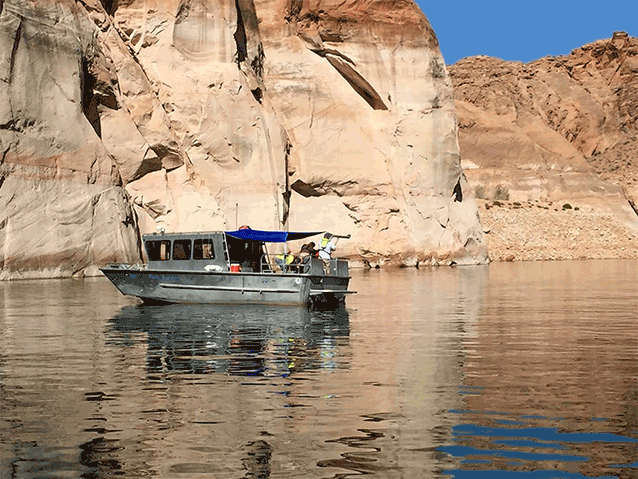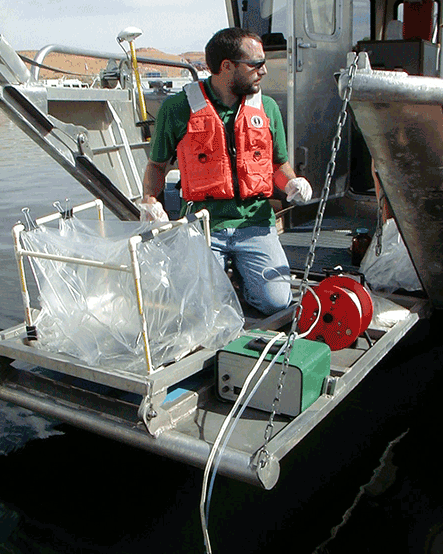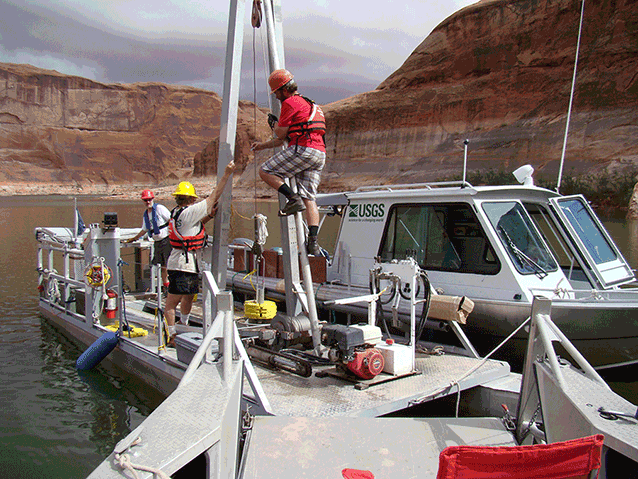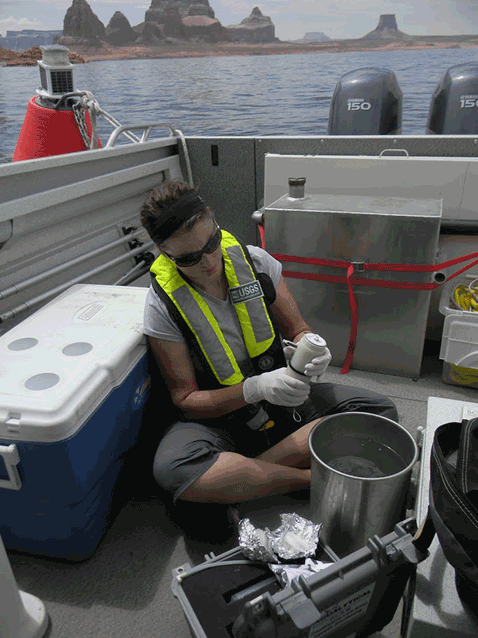The National Park Service and US Geological Survey work together in researching the different types of contaminants that may arrive at Lake Powell, and how to address them. Keeping Glen Canyon Crystal Clear is an NPS Centennial Call to Action.

NPS Photo
Glen Canyon National Recreation Area (NRA) encompasses over 1.2 million acres and includes the popular boating destination of Lake Powell. Contaminants in water and sediment can threaten recreational uses and aquatic life. Potential sources of contamination include runoff from the watershed, atmospheric deposition, and activities of the recreating public, including the use of gasoline and diesel engines and other incidental discharges from boating and camping. The National Park Service centennial Crystal Clear Call to Action item brings together NPS scientists, park managers, and our partners to protect the health of America's waters for the next century.
The discharges from boating and camping can include a wide range of contaminants including “emerging contaminants” that are typically not monitored but have potential environmental or public health risk even at very low concentrations. Emerging contaminants include detergents, fragrances, prescription and nonprescription drugs, disinfectants, and pesticides. Often these chemicals enter the environment after human consumption in wastewater, which is typically not treated for these chemicals. A study conducted in cooperation with USGS in 2001-2002 examined contamination from visitor use in side canyons. Low levels of emerging contaminants, hydrocarbon pollution, and other substances were detected and their relationship to differing levels of visitor use were shown. A report from the study is available at https://pubs.usgs.gov/sir/2004/5120/.

NPS Photo
In 2003 the National Park Service adopted regulations for the management of personal watercraft on Lake Powell. These regulations require Glen Canyon NRA to monitor for hydrocarbon contamination (primarily from gasoline and diesel fuel) in the lake. During 2004, 20 sentinel sampling sites were established at various locations such as marinas, inflow areas, and selected high-use sites; information on the site selection is available at https://pubs.usgs.gov/of/2012/1237/. The NPS has partnered with USGS on multiple studies to assess contaminants and their potential for accumulation in organisms at the established sites. The contaminants examined in the studies, including volatile organic compounds, total petroleum hydrocarbons, oil and grease, and select trace elements, were all at very low levels in Lake Powell. Some potential exists for accumulation in organisms and additional study is underway. A report from sampling in 2010 and 2011 is available at https://pubs.usgs.gov/of/2013/1299/. These results provided baseline information for long-term monitoring and to document change over time.

NPS Photo
Many contaminants enter Lake Powell in runoff from the watershed. Sources of these contaminants are many, and include outflow from mining areas and natural erosion of geological formations which include potential contaminants, such as uranium. Many of the contaminants that enter from the watershed will adhere to sediment particles transported in rivers and settle out when the river enters Lake Powell. The inflow areas on Lake Powell have vast sediment deltas, exceeding 100ft in depth in the major inflow areas. Contaminants in sediment deltas can be remobilized by inflowing rivers, especially as the lake levels drop. In that remobilization, contaminants can affect aquatic organisms and accumulate in the food chain. To assess the contaminant load in the sediment deltas, cooperative NPS/USGS studies have been conducted to analyze contaminants from sediment core samples. A study on the Colorado River sediment delta contaminants is available at https://pubs.usgs.gov/of/2005/1178/, and a study on the San Juan and Escalante River sediment deltas is available at https://pubs.er.usgs.gov/publication/ofr20141096. Long term monitoring of sediment contaminates is being planned with partners to address the threat sediment contaminants present and to respond to contamination events such as the Gold King Mine spill, which occurred in the San Juan river watershed in 2015.

NPS Photo
An advisory on consumption of striped bass in the southern portion of Lake Powell has been issued by the states of Utah and Arizona due to elevated mercury contamination in fish tissues (http://www.fishadvisories.utah.gov/). Mercury exists at levels that can be problematic in virtually all areas of the world; it is primarily sourced from coal fired power plants in China. Biological processes transform elemental mercury to methylmercury that can accumulate in organisms and lead to advisories for consumed species. An investigative NPS/USGS study is being conducted 2014-2016 to identify processes in Lake Powell that may be contributing to the mercury levels in striped bass.
Future studies to continue monitoring hydrocarbon constituents, emerging contaminants, mining pollution, and mercury in water and sediments in Glen Canyon National Recreation Area are being planned to advance understanding of the issues and help guide management. A new study on hydrocarbons in Lake Powell is beginning in 2016. Additional mercury research needs have been identified from the on-going study and investigations will hopefully begin in 2017. A range of partners is interested in new coring efforts in the sediment deltas to further characterize the historical contaminant load and compare it with events such as the Gold King Mine spill.
Glen Canyon National Recreation Area is very remote and many contaminant sources typical for waters do not exist. Contamination that is in the park has been shown to be quite low and none of the contaminants were found in concentrations that exceed water quality standards or threaten recreational uses or the public health of visitors. These efforts of the NPS with partners to understand contamination in Glen Canyon and protect park waters to preserving the ecosystems and recreational uses in the park for current and future generations address the NPS centennial Crystal Clear Call to Action item, which brings together NPS scientists, park managers, and our partners to protect the health of America's waters for the next century.
Last updated: August 26, 2016
